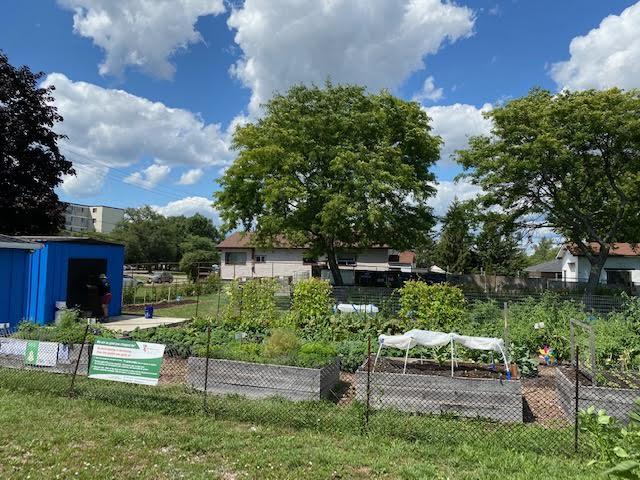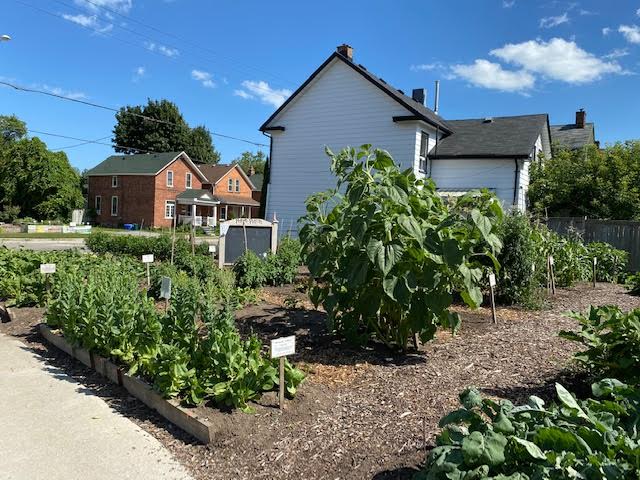Learn more about projects that We Grow Food has developed in the past.
Corporate Community Days
Corporate Community Days have now been taken over by
Participate in maintaining vibrant communities through the access of fresh food grown in our neighbourhood gardens.
We offer a diverse, inclusive, and safe space in connecting to our food in an environmental, sustainable and health conscious way. We offer full and half day volunteer programs, outdoors in beautiful, productive, food gardens.
There are neighbourhood gardens at:
- Alexandra’s Bounty (364 Simcoe St N)
- Pepper Patch (John and Albert St)
- South Patch (Cordova Park, Glen St)
- Carea CHC (115 Grassmere Ave)
What are some of the tasks you may participate in?
- Planting and Maintaining Gardens
- Building beds and trellising
- Maintaining pollinator gardens
- Painting and installation of signage
- Assisting with a wide variety of Garden Programs
Kitchen Garden Kits
In the spring and summer of 2020, We Grow Food handed out 250 FREE planters with the financial support of some of our private funders, including Taking IT Global and the Carea Community Health Centre.
As we followed up with participants on the progress of their kits, we saw a genuine enthusiasm in sharing what they were growing and how they were learning about growing food. WGF has been mapping the Kitchen Garden Kit program’s success, in the hopes of connecting all of these amazing urban farmers together.
You can visit the map of the Kitchen Garden Kit Project here.
Mobile Greenhouse
The Mobile Greenhouse Classroom had We Grow Food leaving the established neighbourhood gardens in Oshawa and venturing out into Durham Region’s schools to deliver outdoor, interactive, educational programming about connecting to food in a sustainable way including how these practices can positively impact the environment.
Our goal was to inspire and teach students about eating a healthy and sustainable diet and doing well by the environment. These programs covered topics like food security, biodiversity, water conservation, permaculture, composting, why we eat fresh food and the importance of supporting and growing local food.
Through our programs we inspire advocacy; we teach the value of connecting with the earth through our food and we demonstrate to youth how they have a direct impact on the environment. We Grow Food offers a direct and complimentary connection to any school’s curriculum of environmental studies, biology or food sciences.
Learning Modules:
What are Sustainable eating practices?
Through discussion and creative expression through sign painting we explore sustainable eating and how to become an advocate in your community
What is composting and why we do it?
We learn that Reducing, Reuse and Recycling, are important in creating sustainable communities. Composting is natures way of recycling. By understanding how composting work we look at displays of a variety of compost systems in different timelines. Students will work in groups to make compost the perfect compost pile and then a compost tea which is the perfect fertilizer and natural insecticide.
Water Conservation and Catchment
Through the timing water run off through a variety of soil qualities we learn the importance plants and trees make in our environment. We continue on to learn how to make a wicking bed and self-watering systems through capillary action. Each student has the opportunity to assemble and plant their own wicking pot
Bees and Pollinators
Some say that the end of pollinators is the end of our food. Here we discuss and dissect the parts of a flower to understand its reproductive system and the role of pollinators. Here students have the opportunity to plant a pollinator pot or build a bee condo.
Seed Saving for the Future
A hundred years ago seed saving was common practice. With over 75% of our varieties of vegetables going extinct we learn the about how to seed saving for our future. A variety of fruits and vegetables will be used to extract seeds for saving.
Using What we Grow
A part of eliminating waste is knowing how to use and store, for use at a later date, what we grow and what we purchase at markets. A display of a variety of storage methods will be reviewed including dehydrated foods using solar vs an electric dehydrating techniques. Students will then be put into groups where they are given the challenge of creating a recipe on a fixed budget (using the produce provided) and preparing food for the whole group.
Understanding Our Soil & How it Helps Things Grow
Understanding our soil is one of the first steps to successful growing. The first experiment is to identify the type of soil we have. The second experiment it looking at how water absorbs into and stays in our soil by running water through a variety of soil conditions and looking at the quality and quantity of the water that runs through it. How do the results impact our decisions on augmenting the soil and what we will grow.
Building and installing a food project
When deciding to install a garden and or raised bed, several garden building steps will have been decided on before the build while some will be completed at the build. Students will have an active role in designing the plant layout, based on plant requirements. They will then build the beds using a series of tools including, drills, hammers, staple guns, shovels, wheel barrows.
Permaculture: the food garden that keeps giving
Students will be introduced to the 12 principles of permaculture and how they are incorporated not only into our lives but into the food gardens we create. Living in harmony with nature creating sustainable communities and systems.
The Gardens
Here’s a list of our beautiful gardens, alongside pictures and a description of how they came to be and what they’re all about.
Alexandra’s Bounty
Built in the fall of 2016, it was ready for planting in the spring of 2017. This incredible 69′ diameter circular raised bed garden was built by over 50 people in a mere 8 hours! Incredible what can be done with many hands. Here we grew over 40 different herbs, vegetables and fruits. Here we have a gazebo that not only catches water for watering but is a lovely spot, used by many, to sit and watch the garden grow. There are wicking beds, row covers, and bee condos. There is a pollinator garden that was installed by Lakeridge Adolescent Out Patient clients and a butterfly garden. Alexandra’s Bounty is visited by residents of the neighbourhood, visitors to the hospitals looking for respite, and schools. Education is on-going from composting to cooking in the garden.
The South Patch
The South Patch, located in Oshawa’s Cordova Park began June 2015. With dozens of people coming to move a mountain of soil into 100-foot beds along with a series of raised beds, a hedge of raspberries and a few fruit trees. This garden, in South Oshawa supports and impacts over 100 families that come and harvest from dozens of food items. A lovely sight is watching a child run across the street, from the apartments, and gathering up some basil says with a smile “my mom is making spaghetti sauce”. The garden is abundant and Sheila, Adam and the kids make sure to make a weekly run of excess produce to the food bank. With summer programming, three times a week beginning in the summer of 2016 through the Healthy Kids Oshawa program we have seen many more families coming and spending time at the South Patch.
The Carea Gardens
Spring of 2018 We Grow Food was approached by Carea Community Health Center to see if we would manage the large food gardens out back. This would be our 5th neighbourhood garden in Oshawa, making the total of urban land farmed almost 2 acres. This year the garden was changed from plot holders to a shared garden format. Carea’s Garden of Health is abundant offering fresh produce not only to fulfill their fresh produce programs and food hampers , but enough extra to be distributed to WGF’s community agencies that have increased ten fold due to COVID-19.
The Pepper Patch
The Pepper Patch Community Garden was started in 2013 by We Grow Food and enthusiastic members of the downtown Oshawa community where it is located on a vacant City of Oshawa lot. From the beginning the garden has been a huge asset to the area. Working together to grow healthy food, meeting new people, sharing produce with others, and beautifying the neighbourhood are benefits that can’t be matched! The current motto is Growing Healthy Community Together.
The Berry Patch
The Berry Patch Garden followed in 2014. Utilizing raised beds (built by the local volunteers with wood donated by Oshawa businesses) this garden grows many herbs. In addition there are numerous berry bushes and a few dwarf fruit trees. The Berry Patch also has an outdoor stage which brings local musicians and neighbours together.
Skills Development
We Grow Food’s Urban Neighbourhood Farming helps fill needs,
solving some of the problems we face in priority neighbourhoods
• Provide volunteer opportunities and sweat equity rewards.
• Youth, along with the community at large that will have access to knowledge about how food is grown, harvested and stored.
• Youth and volunteers will learn transferable skills.
• Provides venues for We Grow Food to offer outdoor Healthy Kids Programming from May to September.
• We Grow Food created a replicable model that can be used in other communities.
• Access to fresh “hyper local” food and working towards growing fruits and vegetables year- round. Contributing to eliminating food deserts in the city.
• Reduce urban poverty and food insecurity while enhancing our neighbourhood’s health and well-being.
• Stimulate local economic development, create more safe and inclusive space, continue to green the city and have an environmentally positive impact on land that is underutilized.
• Deliver social integration.
• Offer recreational opportunities for our neighbours through programming and volunteer placements.
• Open the door to training opportunities and mentorship by inviting Local Farmers, Durham College, and various schools and groups in the area to give on-site training to students and neighbours.
• Implement the use of technologies such as hydroponics, drip irrigation, zero tillage, aquaponics, etc. These tools will encourage innovation amongst the users.


























































